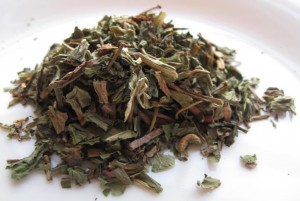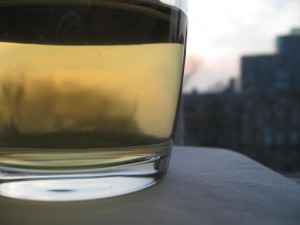Last updated: March 21, 2013
Note: this article is about dandelion leaf tea. Click to read the article on dandelion root tea, also known as dandelion coffee.
Dandelion tea is a caffeine-free herbal tea made from the leaves of the dandelion plant. There are a number of different dandelion species in the Taraxacum genus. The species most commonly used for tea is Taraxacum officinale, often called the common dandelion.
Dandelions have been used as food for centuries over large parts of the globe. The leaves are commonly eaten raw or cooked as dandelion greens and the flowers are used to make dandelion wine.
Appearance
The dried dandelion leaves are deep grey-green mottled with brown and have thick purple veins running through them. Dry dandelion tea smells spiced with notes of oregano and basil.
Making dandelion tea
- Use 1 or 1.5 teaspoons of dandelion tea for every cup of hot water.
- Heat your water. Don’t boil it! Dandelion tea is fairly bitter; using boiling water will make it even more so. I use water at about 80C (175F). If you have a thermometer, use it; if you don’t, your water should just barely begin to show tiny bubbles at the bottom of the pot.
- Pour the hot water over the dried dandelion leaves.
- Leave to infuse for 3-5 minutes.
- Strain out the dandelion tea, serve and consume.
Drinking dandelion tea
For my first attempt at making dandelion tea, I used boiling water as I typically do for herbal tea. That was a mistake. The brewed tea tasted positively foul, awash with bitterness and without many other flavors.
After I lowered the water temperature to 80C (175F), things improved a little, but not much.
Color: pale amber after infusing for 5 minutes. Very light, fully transparent. After 20 minutes, the color is a deeper, richer gold.
Aroma: some spice with a slight smell of aniseed. Flat.
Taste: after 3 minutes, slight saltiness with mild grassy notes and an undercurrent of bitterness. Bitterness aside, the flavor is best described as “generic herbal tea” which is not a compliment by any means. Mild and boring. Bitterness is distracting and mildly unpleasant but tolerable. Has a faint chemical quality like the smell of chlorine at a swimming pool.
After 5 minutes, very little has improved. The bitterness is noticeably stronger and now builds between sips. There’s a chemical called denatonium that tastes so bitter it’s added to antifreeze and rat poison to stop children accidentally eating them. It now feels as if the inside of my mouth is coated with it. The bitter aftertaste remains long after finishing the tea, even after rinsing with water.
As I imagine you’ve worked out by now, I think this is pretty rotten stuff. I can’t think of anything positive to say about it from a gastronomic perspective. It tastes bad. Really bad.
Dandelion leaf tea benefits
Human trials
A small pilot study found that an extract of the leaves of the common dandelion (T. officinale) appeared to “show promise” as a diuretic in humans.
There is also a case report of a dandelion herbal supplement causing hypoglycemia (low blood sugar) in a diabetic woman.
Research
A large number of phytochemicals with potential effects in humans have been identified in dandelion leaves1. Research in animals and humans is ongoing to identify plausible but unproven anti-inflammatory, anti-sclerotic, anticarcinogenic and immunomodulatory effects, among others. At present, there’s no clinical evidence for any of these effects in humans.
I had a rather more positive experience with dandelion root tea.


